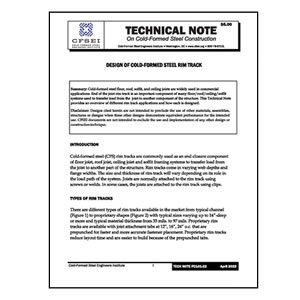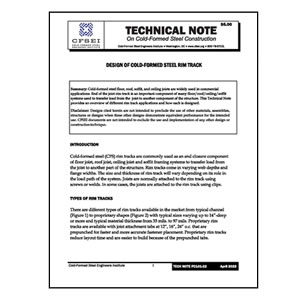Tech Note J100-23: Cold-Formed Steel Floor Joist Design
$5.00
This Tech Note Updates and Replaces Tech Note J100-11
Summary: Cold-formed steel (CFS) joists have become very popular where non-combustible material and long unsupported spans are required in design. The purpose of this Tech Note is to provide a review and summary of the AISI S240, North American Standard for Cold-Formed Steel Structural Framing and S100, North American Specification for the Design of Cold-Formed Steel Structural Members design requirements for cold-formed steel floor joists.
Disclaimer: Designs cited herein are not intended to preclude the use of other materials, assemblies, structures or designs when these other designs demonstrate equivalent performance for the intended use. CFSEI documents are not intended to exclude the use and implementation of any other design or construction technique.
Related Products

Tech Note B007-20: General Considerations for Cold-Formed-Steel Connections
Summary: Cold-formed steel (CFS) connections present unique design challenges to consider due to the thickness of the steel. Connections with thin steel materials behave differently than connections with thicker hot-rolled steel materials and are prone to unique limit states. This Technical Note is an introduction to typical CFS connection design issues as defined by common limit states.
Disclaimer: Designs cited herein are not intended to preclude the use of other materials, assemblies, structures or designs when these other designs demonstrate equivalent performance for the intended use. CFSEI documents are not intended to exclude the use and implementation of any other design or construction technique.

Tech Note F501-11: Cold-Formed Steel Truss To Bearing Connections
Summary: This Technical Note is intended as general educational information and to highlight what the building designer should be aware of with regard to truss to bearing connections. Topics addressed include what loads due to wind truss to bearing connections may have to resist, who is ultimately responsible for truss to bearing connection design, general guidance on the design of truss to bearing connections, and an illustrative design example. Loads due to seismic forces are not addressed in this Technical Note.
Disclaimer: Designs cited herein are not intended to preclude the use of other materials, assemblies, structures or designs when these other designs demonstrate equivalent performance for the intended use. CFSEI documents are not intended to exclude the use and implementation of any other design or construction technique.

Tech Note B006-20: Introduction to Evaluation Services and Explanation of Evaluation Reports
Summary: Evaluation reports act as a bridge between authorities having jurisdiction (AHJs) and manufacturers in conveying specific information on building products and systems relative to compliance to codes and standards. When an evaluation report is made available and determined as supporting the product’s use in projects, approval of the code official should be solicited. After such approval is attained, the design and installation details given in the report need to be observed and the labeling of the actual product needs to match the description provided in the evaluation report.
Disclaimer: Designs cited herein are not intended to preclude the use of other materials, assemblies, structures or designs when these other designs demonstrate equivalent performance for the intended use. CFSEI documents are not intended to exclude the use and implementation of any other design or construction technique.

Tech Note F602-20: Screw Connections with Other Materials or Gaps Between the Plies
Summary: Screws are the most common connection type for connecting cold-formed steel members to one another. It is also common for gaps to be provided between members in the form of other materials such as gypsum or insulation, but unfortunately, the current standards do not provide clear direction for the design of screwed connections with gaps in the material. This Tech Note will summarize available test data and propose design guidance based on the available test data.
Disclaimer: Designs cited herein are not intended to preclude the use of other materials, assemblies, structures or designs when these other designs demonstrate equivalent performance for the intended use. CFSEI documents are not intended to exclude the use and implementation of any other design or construction technique.

Tech Note B003-20: Introduction to Building Codes
Summary: The International Code Council develops a suite of building codes that are considered nationally to be the model codes for the building industry. Local jurisdictions adopt, and in some cases amend, the codes and they become the law of the jurisdiction for building design and construction. The adopted building codes are intended to provide minimum requirements to provide a safe building environment. Among other requirements, the code dictates the maximum allowable size of a building based on its intended use, materials used in construction, fire resistance rating of structural elements, and the presence of automatic sprinkler systems. The International Building Code establishes all design loads to be applied to the building or structure. The building code also relies on references to other standards and specifications to ensure the provisions reflect the current industry practice. For cold-formed steel framing, the IBC references the American Iron and Steel Institute’s suite of framing standards as the accepted design methods and procedures.
Disclaimer: Designs cited herein are not intended to preclude the use of other materials, assemblies, structures or designs when these other designs demonstrate equivalent performance for the intended use. CFSEI documents are not intended to exclude the use and implementation of any other design or construction technique.

Tech Note W102-21: Introduction to Curtain Wall Design using Cold-Formed Steel
Summary: A curtain wall can be defined as a non-vertically loaded exterior wall (aside for self-weight) support by the primary structural frame of the building. When it comes to cold-formed steel framing, this definition can encompass a great many possible assemblies and applications. This Technical Note discusses the various structural elements of a curtain wall system, and introduces the subjects of design loads and framing analysis.
This Technical Note updates and replaces CFSEI Tech Note W102-12
Disclaimer: Designs cited herein are not intended to preclude the use of other materials, assemblies, structures or designs when these other designs demonstrate equivalent performance for the intended use. CFSEI documents are not intended to exclude the use and implementation of any other design or construction technique.

Tech Note S300-21: Coordinating Cold-Formed with Metal Buildings
Summary: This Technical Note presents a discussion of both the design responsibilities and the need for coordination when integrating field-framed, i.e., stick-built, cold-formed steel (CFS) framing with a metal building system. Important potential coordination topics connection details and design concepts are highlighted.
Disclaimer: Designs cited herein are not intended to preclude the use of other materials, assemblies, structures or designs when these other designs demonstrate equivalent performance for the intended use. CFSEI documents are not intended to exclude the use and implementation of any other design or construction technique.

Tech Note L200-09: Roof Framing Anchorage Forces: MWFRS or C&C
Summary: This Technical Note defines the two levels of force and discusses the effects of using Component and Cladding (C&C) loads versus Main Wind Force Resisting System (MWFRS) calculated uplift loads. Design examples are provided to indicate the difference in roof-to-wall anchorage force for either type of load. Mainstream reference standards and quotes from field experts are cited when discussing the appropriate levels for calculating the uplift forces.
Disclaimer: Designs cited herein are not intended to preclude the use of other materials, assemblies, structures or designs when these other designs demonstrate equivalent performance for the intended use. CFSEI documents are not intended to exclude the use and implementation of any other design or construction technique.

